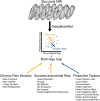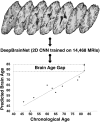More than chronic pain: behavioural and psychosocial protective factors predict lower brain age in adults with/at risk of knee osteoarthritis over two years
- PMID: 41020178
- PMCID: PMC12465110
- DOI: 10.1093/braincomms/fcaf344
More than chronic pain: behavioural and psychosocial protective factors predict lower brain age in adults with/at risk of knee osteoarthritis over two years
Abstract
The interplay between chronic musculoskeletal pain and brain ageing is complex. Studies employing machine learning models to assess relationships between brain age and chronic pain generally show that higher chronic pain severity associates with older brain age. Analyses to date have not considered individual and community-level socioenvironmental risk factors or behavioural/psychosocial protective factors as potential modifiers of cross-sectional and longitudinal brain age. This study aimed to elucidate the relationships between chronic pain, socioenvironmental risk, behavioural/psychosocial protective factors, and brain ageing. The sample comprised 197 adults (Men:Women = 68:129) from a prospective observational cohort study. Most individuals reported knee pain and were with/at risk of osteoarthritis. A subset of 128 participants (Men:Women = 41:87) completed a follow-up MRI session at 2 years and were included in the longitudinal analysis (Aim 2). Participants were 45-85 years of age and self-identified as non-Hispanic Black or non-Hispanic White. Data collected included demographics, health history, pain assessments, individual and community-level socioenvironmental factors (education, income, household size, marital and insurance status, and area deprivation index) coded as a summative socioenvironmental risk variable, and behavioural/psychosocial factors (tobacco use, waist circumference, optimism, positive and negative affect, perceived stress, perceived social support, sleep) coded as a summative behavioural/psychosocial protective factor variable. Structural MRI data were used to estimate brain age by applying a machine learning approach (DeepBrainNet). Cross-sectional analyses utilized regression and analysis of variance, while longitudinal analyses utilized a linear mixed model. Higher chronic pain stage and socioenvironmental risk are associated with an increased brain age gap (the difference between chronological age and predicted brain age). Participants who had higher socioenvironmental risk had brains that were about three years older than those of participants with lower risk. Having more behavioural/psychosocial protective factors correlated with a lower brain age gap; participants with higher behavioural/psychosocial protective factors had brains that were over three years younger than participants with fewer behavioural/psychosocial protective factors. Longitudinally, higher baseline behavioural/psychosocial protective factors are associated with lower brain age over the 2-year span, beyond the effects of chronic pain stage and socioenvironmental risk. Our findings show behavioural/psychosocial protective factors may counteract neurobiological ageing and help buffer the brain from chronic pain.
Keywords: behavioural/psychosocial protective factors; brain age; chronic musculoskeletal pain; machine learning; socioenvironmental risk.
© The Author(s) 2025. Published by Oxford University Press on behalf of the Guarantors of Brain.
Conflict of interest statement
The authors report no competing interests.
Figures




References
-
- Briggs AM, Cross MJ, Hoy DG, et al. Musculoskeletal health conditions represent a global threat to healthy aging: A Report for the 2015 World Health Organization World Report on Ageing and Health. Gerontologist. 2016;56(Suppl 2):S243–S255. - PubMed
-
- Global Burden of Disease Study C . Global, regional, and national incidence, prevalence, and years lived with disability for 301 acute and chronic diseases and injuries in 188 countries, 1990–2013: A systematic analysis for the global burden of disease study 2013. Lancet (London, England). 2015;386(9995):743–800. - PMC - PubMed
-
- Hoy D, March L, Brooks P, et al. The global burden of low back pain: Estimates from the global burden of disease 2010 study. Ann Rheum Dis. 2014;73(6):968–974. - PubMed
LinkOut - more resources
Full Text Sources
Miscellaneous
